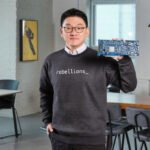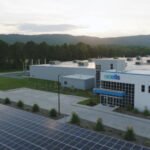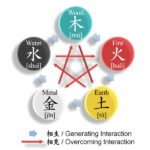
LG Display Co., the world’s top organic light-emitting diode (OLED) panel maker, on Thursday unveiled a fourth-generation screen optimized for artificial intelligence-powered TVs as it strives to expand its presence in the large-size premium panel market.
The new OLED panel boasts improved image quality with higher brightness and enhanced energy efficiency compared to its previous models, thus ideal for power-intensive AI TVs, according to the company.
The panel improves screen brightness by 33% compared to the previous generation and achieves a maximum brightness of 4,000 nits – the industry’s highest.
One nit is the brightness produced by a single candle.
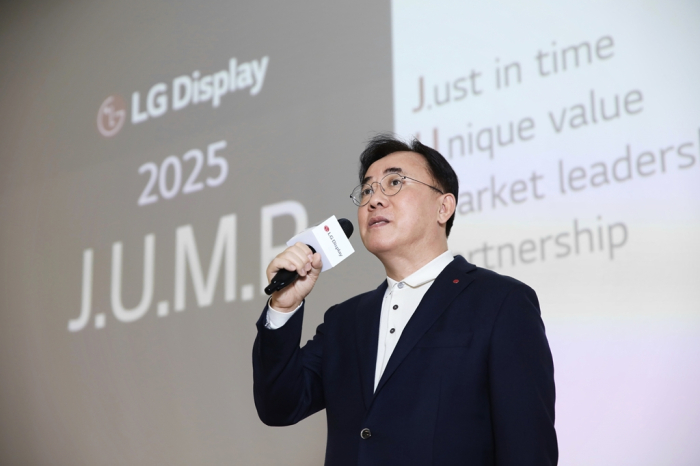
LG said the new OLED panel enables ultra-high 8K picture quality, offering rich, true-to-nature colors and brightness levels that are as vivid and three-dimensional as seen with the human eye.
“Our fourth-generation OLED TV panel meets the performance demands of the most advanced AI TVs, interacting in real-time with the TV’s on-device AI to deliver the perfect picture in any environment,” LG said in a statement.
OLEDs is the mainstream in the TV and smartphone segments.
It is highlighted by self-illuminating pixels that do not require a separate light source, allowing manufacturers to produce lightweight, thin and flexible display products, appealing to high-end consumers.
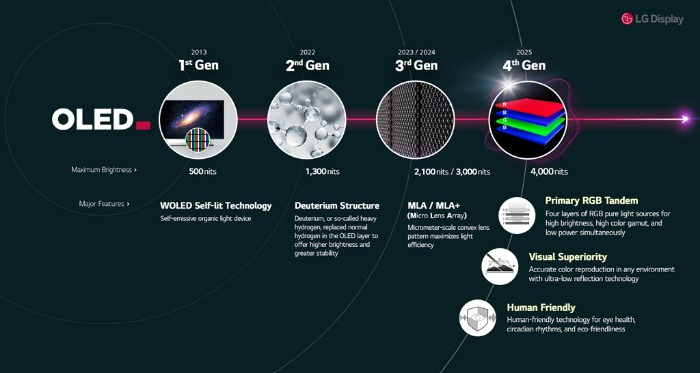
PRIMARY RGB TANDEM
LG said the new panel’s innovation centers on the primary RGB tandem structure – LG’s proprietary technology that uses independent stacks of red, green and blue (RGB) elements to produce light.
The structure applied to the fourth-generation OLED TV panel organizes the light source into four stacks by adding two layers of blue elements and independent layers of red and green elements. Previously, LG used a three-stack light source.
As a result, the new panel boasts a color brightness of 2,100 nits – a 40% improvement over the previous generation.
Thanks to the new structure and power supply system, the fourth-generation OLED screen has achieved 20% greater energy efficiency than the previous generation in the case of a 65-inch panel, it said.

The company said it has also developed a special film that blocks 99% of internal and external light reflections when applied on AI TVs.
LG plans to apply its fourth-generation OLED panel to its top-of-the-line mass-produced TV lineup this year and high-end gaming monitor screens later.
TANDEM OLED FOR VEHICLES
In August, industry sources said LG Display is seeking to supply next-generation tandem OLED displays for vehicles to British luxury automaker Bentley Motors Ltd. and 11 other global carmakers.
The display maker is jointly developing the third-generation automotive tandem OLED with these partners, people familiar with the matter said at the time.

The vehicle partners include Cadillac, the luxury brand of General Motors Co. (GM), and Genesis, the premium brand unit of Hyundai Motor Co., sources said.
A tandem OLED, also known as a stacked OLED, is a type of screen technology that makes displays brighter and last longer. Traditionally, OLED screens have only one layer that emits light. In a tandem OLED, multiple light-emitting layers are stacked on top of each other.
The company developed in 2019 the industry’s first tandem OLED display, mainly used as automotive screens.
According to market research firm Omdia, global annual tandem OLED display shipments are forecast to jump to 71.8 million units by 2031 from an estimated 8.1 million in 2024. The tandem OLED display market is expected to grow to $9.9 billion from $2.5 billion over the same period.
LG Display operates manufacturing facilities in Korea and China and back-end assembly facilities in Korea, China and Vietnam.
By In-Soo Nam
isnam@hankyung.com
Jennifer Nicholson-Breen edited this article.

